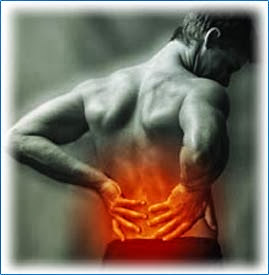Back pain is very common. The causes of Back Pain are varied: obesity, stress, physical labor, pregnancy, sports, aging, etc.. Back problems can come on because of a sudden injury, but more often it results from poor lifestyle habits. Some people have one episode every few years, and they have 1-2 episodes of low back pain every year.
Lower Back Pain is the most common pain, it represents about 85% of cases. Lower Back Pain causes are mechanical and are not a malfunction especially of the spine. It is usually caused by actions or attitudes of daily life: poor posture, violent sport to the spine or lack of physical activity, overweight, stress...
People that are overweight often experience back pain and are suffering simply because they cannot get rid of the weight that is in excess. In fact, if you are carrying around an additional weight in the front of your body, your back is going to suffer as a result.
Stress can also be a cause of back pain. For many people stress is something that they go through on a regular basis, something that they have to deal with and does not cause any physical pain. For others, however, stress can cause a number of different problems including back pain.
A wrong posture can often be due to wearing inappropriate footwear. It can happen that when you have been on your feet a considerable amount of time you begin to experience back pain. Many people think that in this case the pain is caused by their feet but very often are their shoes that are causing this pain.
Low back injuries are often caused by our posture, habits, and past injuries. Many people like to blame their pain on one instance in life. It is true that they probably did damage the area but it didn't mean they will have chronic back pain because of that injury.
People with chronic low back pain usually have weakness in several distinct muscle groups, and their muscles do not work together properly. For any movement, there is a complex series of muscle contractions that should occur in an exact order. Compensation spasms tend to disrupt the order of contraction, which increases the chances that the back won't be able to protect itself in the future. We will be able to perform many activities but there will be greater stress on certain muscles and joints.
Treatment will focus and helping the injured area recovery. It will also be focused at improving the muscle patterns that overwhelm the area. Research has shown that people can improve their muscle patterns, and the improvement leads to less back pain.
While medications can be used to alleviate pain, it is important to know that medicine alone may not be an effective treatment. It is highly recommended for those with a lot of pain to incorporate other forms of treatments such as physical therapy, exercises and adapt to various lifestyle changes. Before taking any medication or trying out any form of lower back pain treatment, it is highly recommended for a patient to make enough consultations with his/her doctor.
Care Plan for Patients with Back Pain
1. Improving physical mobility
Physical mobility is monitored through continuous assessment. Nurses assess how patients move and stand. Once back pain is reduced, self-care activities may be performed with minimal strain on the injured structure. Change of position should be done slowly and assisted if necessary. Circular motion and sway should be avoided. Patients are encouraged to switch activities lying, sitting and walking around for a long time. Nurses need to encourage patients comply with exercise programs according to established, that one just does not exercise effective.
2. Relieves Pain
To reduce pain nurses can encourage patients to bed rest and modification of the position is determined to improve lumbar flexion. Patients are taught to control and adjust the pains that go through the respiratory diaphragm and relaxation can help reduce muscle tension that contributes to lower back pain. Distract patients from pain with other activities such as reading books, watching TV and with imagination.
Massage of the soft tissue, gently is very useful for reducing muscle spasms, improve circulation and reduce the damming and reduce pain. When given the drug the nurse should assess the patient's response to each drug.
3. Improving the performance of the role
Responsibilities associated with the role may have changed since the occurrence of lower back pain. Once the pain healed, patients can return to his role of responsibility again. But when the activity is impacting on the bottom of back pain occurs again, it may be difficult to return to the original responsibility without bearing the risk of chronic low back pain with disability and depression caused.
4. Changing nutrition and weight loss
Weight loss through eating way of adjustment can prevent recurrence of back pain, by means of the rational nutrition plan that includes changes in eating habits to maintain a desired weight.
5. Health education
Patients must be taught how to sit, stand, lie down and lifting objects properly.

ReplyDeleteYoutube to MP3 Converter Online